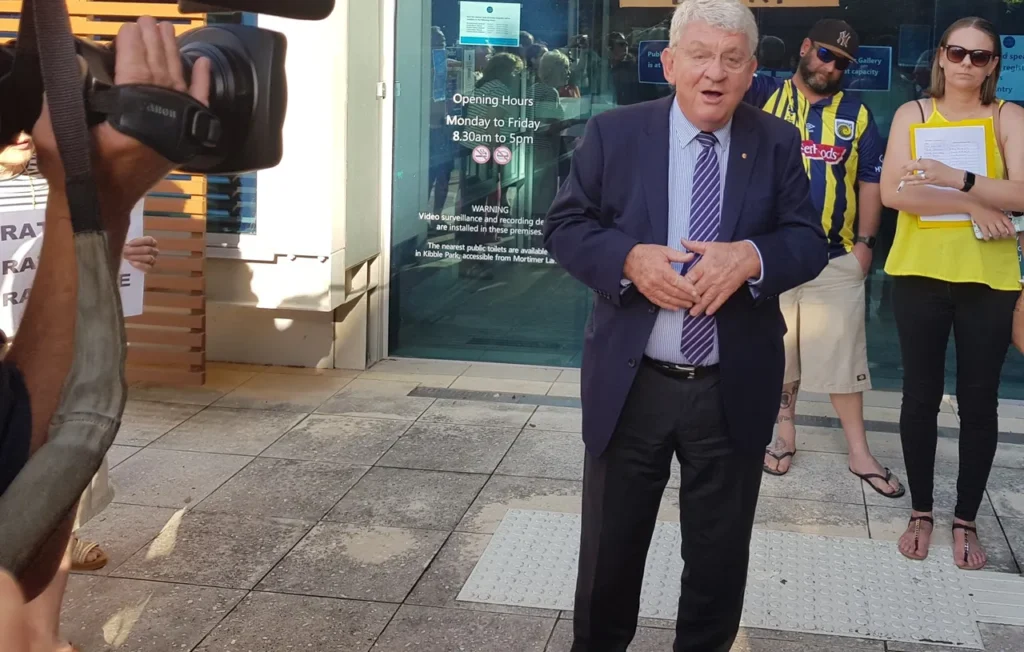
Central Coast Council Administrator, Mr Dick Persson AM, wants everyone on the Central Coast to read and understand his 30-day report and progress report but will they tell you everything you need to know about Central Coast Council’s ongoing financial viability or lack thereof? Jackie Pearson, Executive Producer of thepoint.net.au has read both reports. Here’s what she did and did not learn from them.
Since being appointed Interim Administrator at Central Coast Council on October 30, Mr Dick Persson AM has been on quite a ride. He spent an hour in front of a crowd of hecklers outside the Gosford Council Chamber and featured in an episode of that temple of balanced TV news – A Current Affair.
He was gracious, when informed by one suspended councillor that he had to think about the impact of higher rates on the people of Budgewoi, given that same councillor had, when on Wyong Council, imposed a substantial rate rise on those same people.
He pulled no punches when engaged in a somewhat heated discussion with two suspended councillors after another public meeting regarding his over-reliance on advice from the highly-paid Executive Leadership Team appointed to four-year contracts by the last administrator in 2016.
Mr Persson is, perhaps, counting the sleeps remaining until he returns to retirement on April 29.
Dick, as baseball-capped former councillor, Greg Best, called him during a forum, was appointed by NSW Local Government Minister to do a specific job: “restore the proper and effective functioning of the council.
“There is a clear need for greater oversight and control over the council’s budget and expenditure to restore its financial sustainability and importantly reinstill[sic] the community’s trust in the effective functioning of their council,” Minister Hancock said. Mr Persson would be “fixing council dysfunction”.
He was also “to provide independent governance to address financial, reputational and organisational risks”. Last, but hopefully not least, he was to see that the “best interests of ratepayers are being served now and in the future”.
What’s he been up to?
Has the interim administrator fulfilled his job description? What were his headline achievements between October and March?
He sacked the CEO but did not do so based on performance so Mr Murphy got a payout – perhaps deservedly given his reputation has been left in tatters. The alleged emails between Mr Murphy and one of the Chief Financial Officers (CFO) about potentially unlawful use of restricted funds have not been made public so we cannot judge for ourselves.
He appointed a new CFO who had already been recruited by the CEO he fired.
He employed a Chief Operating Officer with a background in planning to implement “structural change” (read: the removal – via voluntary and forced redundancy – of 300 employees).
Mr Persson’s other achievements have been to secure commercial bank loans worth $150 million. Those loans had strings attached. Council had to agree to reduce staff numbers and ongoing costs and cap infrastructure spending to $170 million per year to get the loans.
The number of Executive Directors has been reduced from nine to five and the number of senior and middle managers from 39 to 26.
Materials and contracts have been cut by $22 million.
He set about selling up to $60 million in “underperforming assets” – land and buildings including the Gosford Council Chamber in Mann St and surrounding land. The Point understands the Executive Leadership Team already has a developer lined up who has told them how much he is prepared to pay for the prime Mann St council building and surrounding land, and that was before the councillors were even suspended.
We await the public information about the valuation and the purchaser.
One “tranche” of the properties to be sold has been made public. It included a wildlife corridor in Doyalson, apparently overlooked by staff. It is not clear if or when the complete list of properties to be sold will be made public.
Assets including the Warnervale aerodrome and the Central Coast Group Training building at Tuggerah have not been listed for sale. Surely Mr Persson will be able to correct some past errors including the sweetheart deal done between the former Wyong Council and CCGT to pay peppercorn rent to the Council while collecting commercial rent from tenants in a brand-new Commonwealth Government-funded building and then get first rights to buy the building off Council. We await the full and frank disclosure of that deal too.
All this has been happening while residents have been focused on the proposed rate rise which IPART may or may not agree to.
Mr Persson’s resolution to take us to a referendum in September to vote on reducing the number of councillors from 15 to nine would make us one of the least represented communities in Australia at a local government level.
Interim report
Mr Persson’s interim report explained how dire the Council’s finances were but refused to blame any of it, apart from IT expenditure, on the 2016 amalgamation.
In a nutshell our Council has almost $600 million worth of debt including the money spent, allegedly unlawfully, from restricted funds. The deficit this year, including $45 million in redundancies and staff entitlements, will be $115 million.
According to the report, Mr Persson requested a three-month extension to oversee the appointment of a new CEO. A new CEO will be in place by early April. The CEO will have to deliver surplus budgets as required by the commercial banks for their $150 million loans. That means Council will have restricted infrastructure budgets for the foreseeable future, unless the loans are paid down or renegotiated.
As a consequence, 50:50 funding arrangements with the NSW Government will be of no use to the Central Coast Council. How the NSW government will deal with its usual expectation that Central Coast Council coughs up 50 per cent of the cost of dredging, emergency coastal erosion works, or vanity walkways at Terrigal, remains to be seen. It’s likely we will miss out on funding altogether. Expect roads, drainage and other public infrastructure to go backwards on the Coast as a result – unless, of course, it’s someone’s pet project with loads of concrete involved.
The interim report stated that a catastrophic error of the newly amalgamated Central Coast Council was its failure to understand it had less than $5 million in unrestricted cash excluding the water and sewer fund. How was that overlooked by former Administrator Reynolds and ACEO Noble?
The interim report revealed that the Water Fund Externally Restricted Reserves and Sewer Fund Externally Restricted Reserves were understated by around $130 million so Councillors thought they had $130 million more cash to spend than they did.
Persson’s interim report identified the three big issues as misuse of restricted reserves (clearly a senior staff responsibility), failure to properly manage the budget (clearly a consequence of use of restricted reserves) and a failure to capitalise on the “efficiencies” of amalgamation.
This is a fundamental flaw in Mr Persson’s report. Of course, as an employer of the NSW Government Mr Persson is hardly in a position to be critical of amalgamation.
Elephant in the room
“I have seen no evidence that the new Council made any serious attempts to identify the type of savings available from merging two large organisations,” the interim report said but the cost of amalgamation is the elephant in the room.
IT expenditure, salary harmonisation (one council had a 35 hour week, the other a 38 hour week) are two examples of amalgamation-related costs that have blown out but the true total cost of amalgamation has never been made clear to the councillors or the public.
What we do know is that money promised from the Snowy Hydro sale did not eventuate. We also know that while our elected councillors were tied up with endless rescission motions and stunts, the NSW Government became increasingly partisan about issues like the cost of dredging and protecting homes from coastal erosion. Cost shifting has been rampant since 2016. If the Central Coast Council has not been able to realise the promised economies of scale, the NSW Government is to blame.
30-day report
The interim report made it clear that a forensic investigation of the causes of spending of restricted reserves and financial mismanagement was a work in progress. The findings certainly have not been conveyed in Mr Persson’s 30-day progress report which runs to six pages.
The new information in the 30-day report included that we will have online access to Council financial information and that steps are being put in place to make sure the current situation doesn’t recur. We still don’t really know how it occurred in the first place.
Mr Persson’s revelation that he and ACEO Mr Hart believe the current executive team is performing well is of interest. That view is not shared by suspended Councillors who retain their conviction they were not provided with the financial information they needed to do their jobs properly.
Two suspended Councillors asked Mr Persson, after a Council meeting, to make public the information he had been supplied about what Councillors did and did not know about the financial situation prior to their suspension. This would be helpful information to place in the public domain.
Some Councillors suggest they were misled and deceived.
Unanswered questions
Here are some unanswered questions that will, hopefully, be put to rest in the Administrator’s final report. Was the spending of internally and externally restricted funds a catastrophic error or deliberate? If the senior leadership team had asked Councillors to resolve that they could use internally restricted funds, such an arrangement would have been permitted. Why was this recommendation never put to Councillors?
If the senior leadership team had done their job and informed Councillors of the need to use externally restricted funds, permission could have been sought from the Minister and their use would have been legitimised. Such a move would have been cheaper than the commercial loans (and their caveats) we are now stuck with for up to a decade.
If councillors had been made aware of the under-estimation, by almost $130 million of sewer and water funds, they would not have accepted the budgets and spending programs proposed by staff. Why was this hidden from most of them? Why did those few Councillors who seemed to have inside information not take steps to involve the whole team of 15?
Was this under-statement of water and sewer deliberate and agreed to by Council’s auditors? Did the NSW Office of Local Government know about this? What systems are being put in place in the NSW Audit Office to prevent any other council from getting into this position given the Audit Office have overseen the audit of Central Coast Council’s annual finances for several years now?
Perhaps all will be revealed in Mr Persson’s final report so the best interests of rate payers will truly be served now and into the future.


